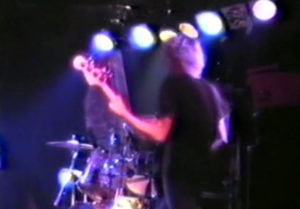Somewhere to Go is a new locally made documentary that hopes to introduce people to the history of Victoria’s vibrant punk rock subculture. Filmmaker Paulina Ortlieb graduated from the University of Victoria in 2014 with a master’s degree in interdisciplinary studies; the film, which Ortlieb worked on for six years, is her master’s thesis and her first feature-length movie.
“The film is about more than just the bands and what they did and where they played; it tries to focus on the importance of subcultures like punk rock for youth,” says Ortlieb. “It covers the inception of punk rock in the late ’70s, but it centres around local Victoria bands. It’s also about the influence on youth in Victoria at that time, largely from bands in the UK and, later, America, too. The film tries to capture more of the sociological aspects of punk rock.”
Victoria has had a sizable punk rock scene for decades. Ortlieb has played bass in some of the bands that have been involved in that scene, most recently for local rockers Budokan; in the past she’s played in, among others, The McGillicuddys and The Vinaigrettes. She’s gone on tour multiple times across western Canada and down to California.

“Punks were often looked down upon by society or thought of as degenerates,” says Ortlieb. “Cops were always trying to bust the shows. Parents were upset that their kids were involved in the scene, but, really, it was so positive for these kids. It kind of provided them with an alternative voice, and it opened doors to new ways of thinking and new forms of expression. I think every generation has to do that, and especially youth; they have a lot of angst and they feel misunderstood. When you get together with a group of people where you can have that expression, it’s just very empowering.”
Ortlieb believes that punk rock culture has been instrumental in influencing and shaping kids and young adults. She says she owes who she is today to her experiences in the subculture of punk rock.
“I think a lot of these kids were really inspired by punk rock, and it led them to do things that they wouldn’t normally have done, and they found a lot of enduring qualities through punk rock that they still believe in to this day, whether they still identify as a punk or not,” says Ortlieb. “The most important thing is busting out of the conventions of society, and doing what feels right for you, regardless of whether or not it’s accepted by society. There will always be a place for punk rock. It’s not so much a musical genre as it is an attitude, and I don’t think that can ever die.”
In the film, Ortlieb interviews dozens of current and former punk rockers from Victoria who discuss the subculture associated with the music. Among them is Rob Nesbitt, a musician who plays in Bum, one of Victoria’s more well-known bands to emerge from the punk scene; he also participated in the production of Ortliebt’s film. Nesbitt has spent many years in the Victoria punk rock scene and has played in several punk bands.
“The film celebrates and highlights the people who’ve been involved in the scene since it began, and highlights the incredible bands that emerged from that scene, people who were pretty much fostered or nurtured in that scene,” says Nesbitt. “At the time that this was happening, people didn’t really realize what was going on—that this was a sort of arts collective fostering and supporting new artists, many of whom went on to have a lifelong career in the arts.”
Nesbitt became involved in the Victoria punk rock scene shortly after moving here. He witnessed the early embodiment of the scene as it unfolded, a brand new genre of music being born before his eyes. He believes that Victoria played an important role during the development of the punk rock movement.
“When the scene reached Victoria, it was still an unquantified element; this was an emerging musical form. The culture that went along with the genre was also emerging and developing organically,” says Nesbitt. “A band would make a song stating an important factor of their belief system, and then that thing would spread like a virus to all points across the globe. There were no major records or radios playing this, but we would always hear about it eventually. The culture was happening, but no one understood exactly what it was or where it was going; it was just constantly evolving, and it was surprising. What people don’t realize, though, is that the punk scene in Victoria was just as vital as anywhere else.”
Somewhere to Go
7 pm Saturday, March 4 (sold out)
The Roxy Theatre
bluebridgetheatre.ca
